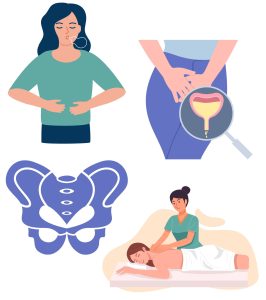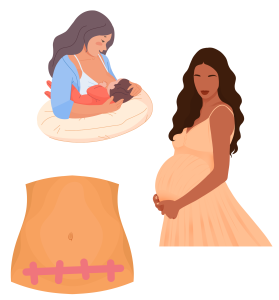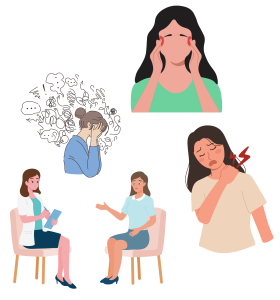4
What is Occupational Therapy in women’s health?
Occupational therapists play a vital role in women’s health by addressing pelvic floor therapy, maternal health, and overall wellness. They help individuals manage bladder incontinence, assist new mothers in finding comfortable feeding positions, and support sexual functioning. These issues can lead to feelings of shame and anxiety, affecting daily life, sleep, work, and social interactions. Building trust is essential for therapists as they connect with clients and address the emotional and spiritual aspects of well-being through a client-centered approach.
Current statistics
- 68% of women did not know that pelvic floor rehabilitation was available to treat pelvic floor dysfunction.
- 4/210 participants have seen an OT for pelvic floor disorder and 44/210 have seen a PT.
- A cross-sectional study of 346 U.S. women revealed that knowledge of pelvic floor dysfunction was insufficient among most participants. Approximately half of the participants had a fair understanding of pelvic organ prolapse, while only about a quarter of the women understood urinary incontinence fairly well.
What is the need?
Currently, many new mothers are actively seeking comprehensive education regarding their physical, mental, and emotional well-being during the postpartum phase. This critical period often sees an alarming lack of dedicated care for mothers, as the majority of attention is directed toward the newborn. It is vital for mothers to establish strong social support systems that offer assistance and understanding during this transformative time.
New mothers require encouragement that reinforces their capabilities in caring for their infants while also navigating the complexities of new co-occupations, which can include balancing household responsibilities and self-care. They benefit from effective coping strategies to manage the wide array of emotions that may arise, such as anxiety, joy, and sadness. Furthermore, setting manageable expectations about the changes that accompany life with a newborn is essential for maintaining mental health and well-being.

Occupational therapist role
As occupational therapists, we can significantly support new mothers by implementing screening assessments before hospital discharge to identify those needing additional resources. Conducting screenings during newborn appointments ensures ongoing care for both mother and child.
Offering home visits or telehealth sessions can provide tailored guidance in the mother’s environment. Establishing dedicated clinics for new mothers can foster community support, allowing them to share experiences and resources.
Additionally, developing online resources like articles, webinars, and community forums, along with literature on adapting to new roles, can empower mothers, helping them find joy and fulfillment in their evolving lives.
Areas of women’s health in occupational therapy may include…
Pelvic floor dysfunction in occupational therapy
-
Breathing and body awareness

-
Bowel and bladder habit training
-
Manual therapy and body work
-
Pelvic disorder and pain management
-
Understanding of anatomy and physiology
Prenatal and postnatal care in occupational therapy
-
Breastfeeding education

-
Environmental modifications
-
Labor and birth preparation
-
Role transition, co-occupations
-
Scar tissue management
Hormones and wellness in occupational therapy
-
Diaphragmatic breathing

-
Menstrual cycle management
-
Nutrition and water
-
Exercise and self-care
-
Intimacy and sexual dysfunction
Mental health in occupational therapy
-
Anxiety and depression

-
Chronic pain management
-
Cognitive Behavioral Therapy
-
Polyvagal Theory and mindfulness
-
Trauma and emotional retraining
Note:
This Pressbook offers an in-depth overview of both general education and specialized training techniques. It emphasizes the significance of additional continuing education courses, which are mandatory for professionals who wish to conduct internal pelvic assessments. These courses equip practitioners with the advanced knowledge and skills necessary to ensure safe and effective assessment techniques, as well as an understanding of the relevant anatomical and physiological considerations.
Key Takeaways
- Women’s health patients have so much to gain from occupational therapy, which can make a significant difference across a wide range of settings and conditions. From improving daily functioning to enhancing overall well-being, the benefits are both versatile and impactful!
Exercises
- Where have you seen occupational therapy for the women’s health population?
- How can you advocate for women’s health patients to receive the care they need?
Explore
References:
Burkhart, R., Couchman, K., Crowell, K., Jeffries, S., Monvillers, S., Vilensky, J. Pelvic floor dysfunction after childbirth: Occupational impact and awareness of available treatment. (2020). Occupational Therapy Journal of Research, 41(2). 108-115. https://doi.org/10.1177/1539449220970881
Jones, J., Domanico, J., Peek, H., Lee, T. E., & Kern, L. A. (2020). Promoting women’s health and wellness. American Occupational Therapy Association.
Loesche, S. J. (2018, May 31). Maternal health and occupational therapy: Exploring our role with new mothers. ContinuEd. https://documentcloud.adobe.com/spodintegration/index.html#
Media Attributions
- Untitled design (2)
- pelvic floor dysfunction
- preg
- hormones
- anxiety
